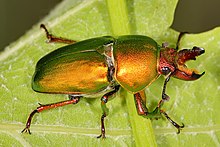
Summary
Stag beetles are a family of about 1,200 species of beetles in the family Lucanidae, currently classified in four subfamilies.[1] Some species grow to over 12 centimetres (4+1⁄2 inches), but most to about 5 cm (2 in).
| Stag beetle Temporal range:
| |
|---|---|

| |
| A male specimen of Lamprima aurata, otherwise known as the golden stagbeetle | |
| Scientific classification | |
| Domain: | Eukaryota |
| Kingdom: | Animalia |
| Phylum: | Arthropoda |
| Class: | Insecta |
| Order: | Coleoptera |
| Suborder: | Polyphaga |
| Infraorder: | Scarabaeiformia |
| Superfamily: | Scarabaeoidea |
| Family: | Lucanidae Latreille, 1804 |
| Subfamilies | |
|
Aesalinae | |
Overview edit
The English name is derived from the large and distinctive mandibles found on the males of most species, which resemble the antlers of stags.
A well-known species in much of Europe is Lucanus cervus, referred to in some European countries (including the United Kingdom) as the stag beetle; it is the largest terrestrial insect in Europe. Pliny the Elder noted that Nigidius called the beetle lucanus after the Italian region of Lucania where they were used as amulets. The scientific name of Lucanus cervus adds cervus, deer.
Male stag beetles are known for their oversize mandibles used to wrestle each other for favoured mating sites in a way that parallels the way stags fight over females. Fights may also be over food, such as tree sap and decaying fruits. Despite their often fearsome appearance, they are not normally aggressive to humans. During a battle between the two males, the main objective is to dislodge its opponent's tarsal claws with its mandible, thus disrupting their balance. Because its mandibles are capable of exceeding its own body size, stag beetles are generally inefficient runners and are very slow, and typically feel the need to fly from one location to another. [2]
Female stag beetles are usually smaller than the males, with smaller mandibles that are much more powerful than the males'.[3] As larvae, females are distinguished by their cream-coloured, fat ovaries visible through the skin around two-thirds of the way down their back.
The larvae feed for several years on rotting wood, growing through three larval stages until eventually pupating inside a pupal cell constructed from surrounding wood pieces and soil particles. In the final larval stage, "L3", the surviving grubs of larger species, such as Prosopocoilus giraffa, may be the size of a human finger.
In England’s New Forest, it was once believed that the stag beetle, dubbed the "devil's imp", was sent to do some evil to the corn crops. The superstition led to stoning the insects on sight, as observed by a writer in the Notes and Queries.[4] Along with rhinoceros beetles, stag beetles are often bought as pets in South Korea and Japan.[5][6]
Evolution edit
The oldest known fossil of the group is Juraesalus from the late Middle Jurassic (Callovian) Daohugou Beds of Inner Mongolia, China. While initially interpreted as a member of Aesalinae, it was later interpreted to be a basal member of the family.[7] Litholamprima, the only genus in the subfamily Litholampriminae, is known from the Lower Cretaceous of Yixian Formation, China.[8]
Antler allometry edit
The Lucanidae males have large antlers. Their size often varies among individuals. Such variation is termed a scaling relationship or static allometry. Environmental conditions and genetic factors affect antler size.[citation needed]
References edit
- ^ Smith, A.B.T. (2006). A review of the family-group names for the superfamily Scarabaeoidea (Coleoptera) with corrections to nomenclature and a current classification. The Coleopterists Bulletin 60:144–204.
- ^ :Goyens J, Van Wassenbergh S, Dirckx J, Aerts P. 2015 Cost of flight and the evolution of stag beetle weaponry. J. R. Soc. Interface 12: 20150222. http://dx.doi.org/10.1098/rsif.2015.0222
- ^ "How to help stag beetles" (PDF). wildlondon.org.uk. London Wildlife Trust. Archived from the original (PDF) on February 2, 2017. Retrieved May 7, 2017.
- ^ Cowan, Frank (December 15, 2012). "Curious Facts in the History of Insects; Including Spiders and Scorpions, by Frank Cowan—A Project Gutenberg eBook". www.gutenberg.org. Retrieved 2022-03-16.
- ^ "[남상호 자연 다큐/곤충 세계 여행④]곤충도 '황금알'을 낳는다". 시사저널 (in Korean). 2001-09-28. Retrieved 2020-07-26.
- ^ Lombardi, Linda (26 May 2014). "How to Care for Your Beetle". tofugu.com. Archived from the original on 6 March 2018. Retrieved 5 March 2018.
- ^ Kim, Sang Il; Farrell, Brian D. (May 2015). "Phylogeny of world stag beetles (Coleoptera: Lucanidae) reveals a Gondwanan origin of Darwin's stag beetle". Molecular Phylogenetics and Evolution. 86: 35–48. doi:10.1016/j.ympev.2015.02.015. PMID 25732069.
- ^ G.V. Nikolajev, D. Ren (2015). "A new fossil Lucanidae subfamily (Coleoptera) from the Mesozoic of China" (PDF). Caucasian Entomological Bulletin (in Russian). 11 (11): 15-18. doi:10.23885/1814-3326-2015-11-1-15-18. Archived (PDF) from the original on February 27, 2024.
External links edit
- Data related to Lucanidae at Wikispecies
- Media related to Lucanidae at Wikimedia Commons
- Flickr Images
- Stag beetle info Research site containing much information on the stag beetle as well as information on current conservation schemes.
- M.J. Paulsen. "Annotated Checklist of the New World Lucanidae". Archived from the original on 2012-02-07. Retrieved 2007-09-14. Checklist of New World stag beetles with links to pages with additional information and images.
- Toma Libich. "Goliathus.com: gallery of Lucanidae".
- "Gallery of Lucanidae". Archived from the original on 2006-10-20.
- J M Maes. "Biodiversity: section on Lucanidae with a world catalogue and a world bibliography".
- Asahinet Stag beetles on postage stamps and species illustrations.
- Lucanes du Monde Image rich French blog
- TOL Archived 2008-09-16 at the Wayback Machine
- UNL Generic Guide to New World Scarabs- Lucanidae,


